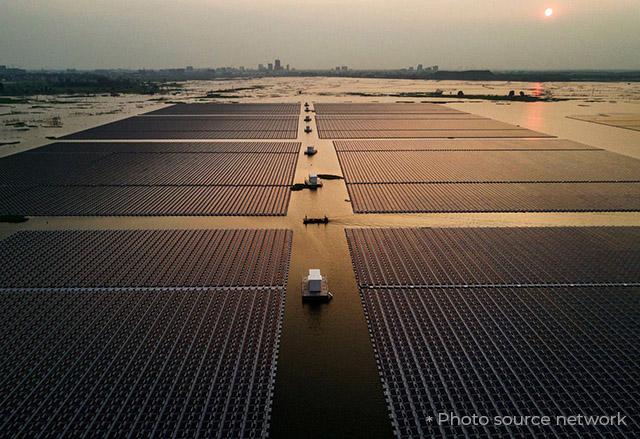As the demand for renewable energy continues to rise, innovative solutions are being explored to maximize the utilization of solar power. In a world of finite land, solar farms can take up a lot of space. But there’s a solution for that scarcity: panels that float.
I. What is Floating Solar Farms?
Floating solar farms, also known as floating solar installations or floating photovoltaic (PV) systems, are a form of solar power generation that involves the deployment of solar panels on bodies of water such as lakes, reservoirs, and ponds. Instead of being installed on the ground or rooftops, the solar panels are mounted on floating structures or platforms that are securely anchored to the waterbed.

II. Advantages of Floating Solar Farms:
The floating solar system is a great efficient system that innovates the limitations of conventional PV sites. Floating PV systems are installed on unused waters to convert unused areas into profitable renewable energy generators. Floating PV systems increase the efficiency of electricity generation due to the natural cooling effect of the water beneath the solar cells.
1. Optimal land utilization: Floating solar farms utilize water bodies that are often underutilized, such as reservoirs or ponds. This helps to conserve valuable land resources that can be used for other purposes like agriculture or urban development.
2. Increased energy generation: The floating nature of these solar farms allows them to take advantage of the natural cooling effect of water bodies. The cooler environment enhances the efficiency of solar panels, leading to increased energy generation compared to conventional solar farms.
3. Reduction in water evaporation: By covering water surfaces with solar panels, floating solar farms help to reduce water evaporation. This is particularly important in water-stressed regions where conserving water resources is a priority.
4. Enhanced efficiency through dual use: Floating solar farms allow for the dual use of infrastructure by combining solar energy generation with water storage or hydroelectric power generation. This helps to maximize the utilization and efficiency of the overall energy system.
5. Minimized environmental impact: Floating solar farms have a lower environmental impact compared to land-based solar farms. They have minimal land disruption, reduce soil erosion, and can provide a habitat for aquatic life, benefiting biodiversity in water bodies.
6. Scalability and flexibility: The modular design of floating solar farms allows for easy scalability and flexibility. They can be expanded or relocated as needed, making them suitable for varying sizes of water bodies and adaptable to changing energy demands.
7. Reduction of transmission losses: Floating solar farms can be installed closer to power consumption centers, reducing the need for long-distance transmission lines. This helps to minimize energy losses during transmission and contributes to a more efficient energy distribution system.
The global floating solar market is witnessing significant growth and is expected to continue its upward trajectory in the coming years. According to industry reports, the global floating solar market size was valued at US 4 billion in 2022 and is expected to hit US 54.09 billion by 2032, poised to grow at a compound annual growth rate (CAGR) of 29.80% during the forecast period during the forecast period 2023 to 2032. This growth is driven by several factors, including increasing environmental concerns, declining costs of solar PV modules, and technological advancements in floating PV systems.
III.Challenges posed by floating solar environments for cabling systems
The global adoption of floating solar farms represents a significant advancement in renewable energy. These innovative installations not only maximize energy generation but also offer various environmental and economic advantages. While floating solar farms offer several advantages, they also pose unique challenges, particularly when it comes to cabling systems. As the floating solar market continues to grow, the development of reliable cabling systems becomes crucial to ensure the efficient and safe operation of these installations.
Traditional land-based solar installations may face issues such as extreme temperatures or physical damage, but floating solar arrays have to contend with additional obstacles. One such challenge is the ever-changing water environment. Unlike their stationary counterparts, floating solar panels are subjected to the constant motion of water, along with exposure to humidity, saltwater, and UV radiation. These environmental factors can accelerate the wear and tear of cabling systems, increasing the risk of cable failure and potential power outages.

To overcome these challenges, SUNKEAN has developed a new type of cable specifically for floating solar installations: the 2PfG/2750 Floating Solar Cable. This innovative cabling solution offers robust performance and durability in aquatic environments, ensuring reliable power transmission for floating solar arrays.
IV. Why do I suggest that you choose Sunkean 2PfG/2750 floating solar cable?
Sunkean floating solar cable is halogen-free, flame-retardant, weather-resistant, UV-resistant, and ozone-resistant. It has also passed TUV 2PfG/2750 certification and has excellent waterproof properties. It can meet the special environment of water photovoltaic projects and can meet the life assessment after 25 years of age required.
On May 24, 2023, TUV Rheinland awarded Sunkean the first 2PfG/2750 standard certification for floating PV cables in China at the 16th International Solar Photovoltaic and Intelligent Energy Conference and Exhibition (SNEC).

Sunkean is at the forefront of R&D and manufacturing of floating PV cables and has always been committed to helping the development of the PV industry and the diversification of PV applications, and actively promoting the industry standardization process. As a new energy cable manufacturer, Sunkean has been committed to providing efficient and comprehensive connection solutions to global customers. We have more products here to meet you, welcome to visit our official website.